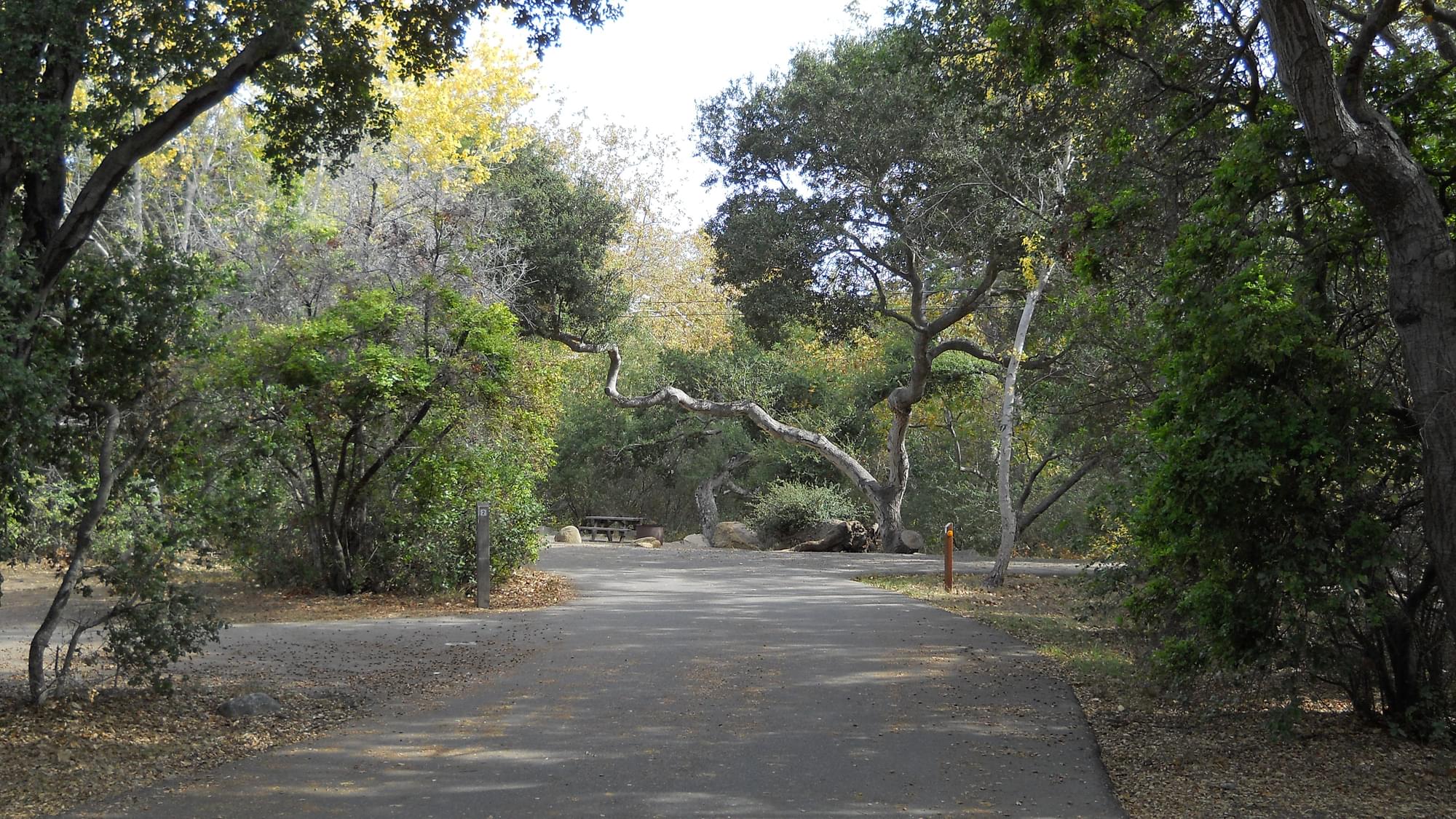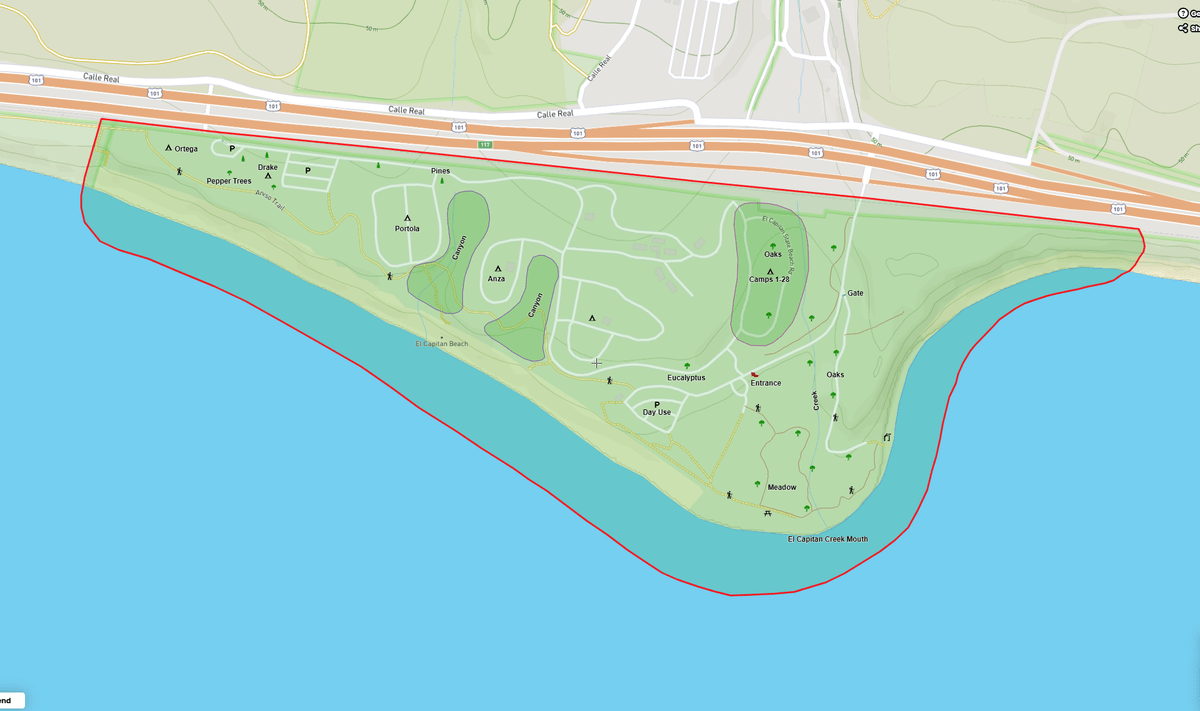El Capitan SB

Tips for Birding
Birding in El Capitan State Beach can be productive all year, but spring and fall will produce the most variety. Post-breeding birds begin to appear in August, and by mid-September fall migration is in full swing. The entrance road into El Capitan SB passes through a scenic stream-canyon woodland where El Capitan Creek flows down to the beach. A nature trail runs along much of the length of the creek starting at the RR trestle next to the 101 Freeway and will take you all the way to the creek mouth and beach. This entire entrance area offers good birding in scenic habitat.
After checking in at the entry kiosk, park in the day-use lot to the left and walk back into the first campground section (campsites 1 – 28). Look through the oaks and shrubs planted around all the campsites and the outdoor amphitheater. Birds moving throughout the campground here will occasionally contain a rarity. During fall and winter months, this first campground is often closed to campers, so you can walk into the unoccupied sites to look through the riparian habitat next to the creek.
From the trail that runs along the entrance road look for the closed gate at a service road marked with a no parking sign. Take this service road over the hill through a canopy of oaks and cottonwoods to reach the ocean. This entire lower creek section can be good for migrants all the way to the creek mouth at the beach. There is also a spur trail here that will take you into the chaparral habitat along the bluff. In wet years there is a large pool at the mouth of the creek and the combination of water and willows next to the ocean serves as a migrant trap attracting many birds. There is no access into the creek bed from these trails.
Scoping offshore from coastal access points and beaches can be good for gulls, terns, pelicans, cormorants, loons, grebes, and scoters. Flocks of Black-vented Shearwaters have been seen close to shore. Western and Clark’s grebe can be easily found just offshore in the cove near the east beach. The rocky shoreline to the east or west of the creek mouth is a reliable place to find Spotted Sandpiper and Wandering Tattler during the appropriate season.
Campsites west of the creek are typically occupied much of the year. These areas contain various pines, cypress, pepper trees, fruiting toyon, and shrubs that can be good for a variety of birds. Aniso Trail is a paved path that runs most of the east-west coastline through these campgrounds for easy walking. Two sizable draws or small canyons are found next to the Anza and Portola campsite loops which can be good for birding.
Birds of Interest
Resident birds typical of woodland habitat include Acorn Woodpecker, Band-tailed Pigeon, Oak Titmouse, Wrentit, Orange-crowned Warbler, and Spotted Towhee. Migrant warblers, flycatchers, and tanagers will be found in the oak and riparian habitat along the creek and in the easternmost campground. Migrant shorebirds will turn up along the rocky shoreline and may include Wandering Tattler, Black Turnstone, and Surfbird. With clear unobstructed views of the ocean, it is possible to spot a jaeger among the gulls and terns moving offshore. Unusual species and rarities include Least Flycatcher, Brown Thrasher, Prothonotary Warbler, Northern Parula, Painted Redstart, and Scarlet Tanager.
About this Location
The park entrance is located at Exit 117 on Highway 101. Park hours are 8:00 AM to sunset. Camping is available by reservation up to six months in advance. There is an entry kiosk with an attendant as you enter the park. The day-use fee is $10.00. Amenities include public restrooms, picnic areas, sandy and rocky beaches, 130 family and group campsites, swimming, surfing, nature trails, and wheelchair access.
Suggested Hotspot boundaries: 101 Freeway and RR tracks (north), the edge of the bluff overlooking the east beach, or the end of the trail along the rocks at the east beach (east), offshore viewing distance limit (south), the west edge of Ortega Group Camp area (west)
Helpful tip - your day-use entry fee into El Capitan State Beach will gain you entrance on the same day to Refugio State Beach, and Gaviota State Park nearby. Retain your parking receipt to enter these other parks for a full day of birding.
The state park was established in 1953 and encompasses around 130 acres of campground and woodland habitat. The oak and sycamore trees along El Capitan Creek offer great birding in a picturesque setting all year, but especially when water is flowing through the creek. The campgrounds have established trees such as coast live oak, pines, Monterey cypress, red ironbark, toyon, eucalyptus, and other planted varieties. Nature trails are located along the creek and in adjacent scrub, and paved pathways are found in the campground areas west of the day-use parking lot. The 4.2-mile Bill Wallace Trail on the north side of the 101 Freeway is not included in this Hotspot but is part of the larger El Capitan State Beach property. This trail climbs into the hills and offers great views of the coastline, the Santa Barbara Channel, and the Channel Islands.
Features
Restrooms on site
Wheelchair accessible trail
Entrance fee
Roadside viewing
Content from Official Website, El Capitan State Beach brochure, and Jamie Chavez
Last updated September 16, 2023
 El Capitan State Beach Hotspot Boundaries
El Capitan State Beach Hotspot BoundariesJamie Chavez